Question: AFCI for branch circuits
The new Section 210-12 of the 1999 National Electrical Code (NEC) requires arc-fault circuit-interrupter protection for some branch circuits. Does UL List such devices?
Answer
Arc-Fault Circuit-Interrupters (AFCIs) are currently covered under the category Circuit Breakers, Molded Case, Classified for Mitigating the Effects of Arcing Faults (DIWL). The Guide information can be found on page 11 of the 1999 General Information for Electrical Equipment Directory (white book). This category covers Listed molded case circuit breakers, which are also Classified after being evaluated for their ability to mitigate the effects of arcing faults that may pose risk of fire ignition under certain arcing conditions.
On Feb. 26, 1999, UL published UL 1699, Standard for Arc-Fault Circuit-Interrupters. Manufacturers have already begun to seek UL Listing of their AFCI products to UL1699, and interest in these products is expected to increase significantly as contractors, electricians and consumers become more aware of their availability and intended application. However, only the branch/feeder type can be used to satisfy the current requirements of Section 210-12, since it requires AFCI protection of the branch circuit. Section 210-12 does not come into effect until Jan. 1, 2002, but is included in the 1999 NEC.
UL tests these devices by using methods that create or simulate arcing conditions to determine their ability to recognize and react to arcing faults. AFCIs are also evaluated to determine their resistance to nuisance tripping caused by arcing that occurs in control
and utilization equipment under normal operating conditions that may closely mimic an arc fault.
Question: Open neutral protection and GFCI
I am very concerned about not having open neutral protection provided on permanently installed ground-fault circuit-interrupters (GFCIs). Who can I contact to try get this requirement changed? Presently, UL 943, Standard for Ground-Fault Circuit-Interrupters, requires portable- type GFCIs used in the field to be provided with open neutral protection. However, permanently wired and installed GFCIs are not required to have open neutral protection.
Answer
Permanently connected GFCIs are more reliable since the connections are hard wired and usually are not disturbed after installation. Assuming the permanently installed GFCI is wired properly, it is very unlikely that the neutral would become damaged, rendering the device ineffective. Open neutral protection may or may not detect a miswired GFCI, and should not be relied upon to determine proper wiring.
Portable-type GFCIs used in the field are generally cord-connected. Open neutral protection is required since the cord is exposed and could be subjected to abuse.
Anyone can submit a proposal to revise a UL Standard. Proposals can be sent to your local UL Regulatory Services representative. It will then be forwarded to the appropriate UL Engineering Services staff. Or, visit the UL web site atwww.ul.com/auth/regcon.htm, and send your proposal or suggestion electronically to UL Regulatory Services.
Question: Open neutral for GFCI
Why is open neutral protection for ground fault circuit interrupters (GFCIs) necessary?
Answer
Switching contacts within a GFCI usually can be activated magnetically by the control circuit of the device, and mechanically by the test and reset buttons. In order for the unit’s control circuit to open these contacts, an imbalance of current (greater than 6 mA) between the ungrounded (hot) and grounded (neutral) conductor is required for Class A devices. Devices must be connected to a live circuit for the control circuit to operate when sensing such an imbalance in the electrical current.
Open neutral protection is required with temporary wiring methods since the cord is exposed and could be subjected to abuse.
Question: GFCI
Why doesn’t UL 943, the Standard for Ground Fault Circuit Interrupters, require visual indicators for proper wiring?
Answer
While UL 943 does not currently require visual indicators for the proper wiring of GFCIs, UL continues to develop requirements intended to prevent their miswiring. UL regularly forwards constituents’ questions and other comments on published Standards, as well as suggestions for developing new Standards, to the appropriate UL engineering staff.
Recent revisions to UL 943 now require that all installation instructions for GFCIs be standardized for consistency. Installation instructions are now essentially identical for all manufacturers. These instructions require specific methods for checking GFCI operation after installation to insure that devices are properly wired. In addition, the statements “Line and Load,” and “Hot and Wired,” are required to be marked on the product near the appropriate terminals. All of these requirements and others currently in place are intended to prevent GFCI miswiring.














Find Us on Socials